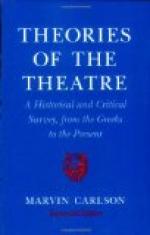The general public seldom knows, and almost never cares, who wrote a play. What it knows, and what it cares about primarily, is who is acting in it. Shakespearean dramas are the only plays that the public will go to see for the author’s sake alone, regardless of the actors. It will go to see a bad performance of a play by Shakespeare, because, after all, it is seeing Shakespeare: it will not go to see a bad performance of a play by Sir Arthur Pinero, merely because, after all, it is seeing Pinero. The extraordinary success of The Master Builder, when it was presented in New York by Mme. Nazimova, is an evidence of this. The public that filled the coffers of the Bijou Theatre was paying its money not so much to see a play by the author of A Doll’s House and Hedda Gabler as to see a performance by a clever and tricky actress of alluring personality, who was better advertised and, to the average theatre-goer, better known than Henrik Ibsen.
Since the public at large is much more interested in actors than it is in dramatists, and since the first-night critics of the daily newspapers write necessarily for the public at large, they usually devote most of their attention to criticising actors rather than to criticising dramatists. Hence the general theatre-goer is seldom aided, even by the professional interpreters of theatric art, to arrive at an understanding and appreciation, for its own sake, of that share in the entire artistic production which belongs to the dramatist and the dramatist alone.
For, in present-day America at least, production in the theatre is the dramatist’s sole means of publication, his only medium for conveying to the public those truths of life he wishes to express. Very few plays are printed nowadays, and those few are rarely read: seldom, therefore, do they receive as careful critical consideration as even third-class novels. The late Clyde Fitch printed The Girl with the Green Eyes. The third act of that play exhibits a very wonderful and searching study of feminine jealousy. But who has bothered to read it, and what accredited book-reviewer has troubled himself to accord it the notice it deserves? It is safe to say that that remarkable third act is remembered only by people who saw it acted in the theatre. Since, therefore, speaking broadly, the dramatist can publish his work only through production, it is only through attending plays and studying what lies beneath the acting and behind the presentation that even the most well-intentioned critic of contemporary drama can discover what our dramatists are driving at.




